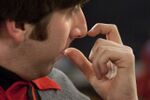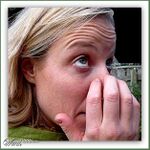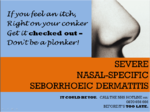Severe Nasal-Specific Seborrhoeic Dermatitis
Severe Nasal-Specific Seborrhoeic Dermatitis, also known as Itchy Nose Syndrome and Sebby D], is a skin disorder affecting millions of different people at any one time. It results in itchy, flaky, and sometimes red skin around the nose area, and occasionally anxiousness. Even though these symptoms do not seem severe enough to warrant any problem, it has been known that in 1 out of every 4000 cases, the victim dies of sudden and unexplained heart failure whilst sleeping. [1]
Causes[edit]
Due to the fact that Severe Nasal-Specific Seborrhoeic Dermatitis is a relatively newly discovered disease, not much is known about its causes. One of the few things doctors do know is that it only affects two groups of people: hypochondriacs and people who use their nose regularly, i.e. people who breathe. People who are hypochondriacs and happen to use their nose for breathing are known to be particularly at risk. [2]
One other possible theory about the disease is that, in fact, it only affects people with particularly large noses. This may be because of the excess heat transferred by the larger nasal surface area causes an increase of sweat and tension, making friction against the surrounding skin, leading to prolonged irritation and skin nerve cell malformation, then to high sensitivity and repetitive nasal scratching, ultimately then progressing to skin flake detachment and redness, then eventually leading to this disease. However, it could also be a coincidence and is therefore nothing to worry about. Doctors are keen to stress that people with big noses are not necessarily going to suffer from this disease at all.
- Unless the person with large nose happens to be a) a hypochondriac or b) someone with eczema. In which case, they should probably be wary of their nasal area and any itches. But they should still be fine. As doctors are keen to stress, Big noses are okay!
- Unless, of course, the person with the big nose has both eczema, is also a hypochondriac, and has been known to have Spontaneous Bouts Of Sneezing. If so, they should seek medical help immediately, and possibly arrange life insurance.
Symptoms[edit]
- For a full list of symptoms, please read Wikipedia. All of it. Not just the Seborrhoeic Dermatitis page, but everything.
There are five general symptoms. The first of these is, fairly obviously, an itchy nose. Other symptoms include having a slightly reddened nose, or flaky skin around the nose. At the very onset of the disease, right at the beginning, however, the only symptom might be simply having the desire to itch your nose, or a nose that looks like it just might go red and flaky. The last possible symptom, of course, is anxiousness.
Because scientists are unsure whether the nasal itching could lead to heart attacks (like it did in one notable case), they do urge people who have these symptoms to get it checked out. As the new NHS slogan says: If you feel an itch, Right on your conker, Get it checked out - Don't be a plonker!" [3]
Prevention[edit]
As can be gleaned from the causes, the people most likely to get it fit two conditions - they are a) hypochondriacs and b) breathe regularly through their nose. Obviously, being a hypochondriac is impossible to change, yet there are still two separate methods to prevent one's self from getting Severe Nasal-Specific Seborrhoeic Dermatitis. Firstly, the potential sufferer could attempt to eliminate nasal breathing, allowing only breathing through the mouth. Several different size pegs are available on prescription for this. Unfortunately, this can actually lead to more irritation of the nasal area, thus being more harm than good. The alternative, slightly more drastic option is the removal of the nose. [4] For some sufferers, this is the only solution. People should take note, however, although this certainly reduces the possibility of Nasal-Specific Seborrhoeic Dermatitis, it also drastically reduces the possibility of them winning a beauty contest ever again (let alone smelling). On top of that, it is a very painful procedure, so people are advised to knock themselves out with a hammer before doing it (possibly by rigging up an intricate system of pulleys and levers?)
The current world expert on the disease, Dr Roshan Patel, has this advice for people considering treatment for the disease:
- Do not under any circumstances remove your nose without proper medical help.
- A Cub Scout badge for First Aid Training does not count as proper medical help.
- No, not even if the Cub Scout got full marks in the test. Put the saw down.
- If someone believes they have the disease, they should stay calm. Do not make contact with anybody, in case it spreads.
It is not known whether Severe Nasal-Specific Seborrhoeic Dermatitis is a contagious disease, yet for safety, people who suspect they have the disease should stay in quarantine. It is likely the disease is contagious, as closely related diseases, such as Repetitive Aural-Specific Seborrhoeic Dermatitis, spread very easily. [5]
It does appear therefore that preventing oneself developing Severe Nasal-Specific Seborrhoeic Dermatitis is very difficult, and almost impossible. One positive fact has been discovered, however. If you cut your own nose off, you are also very likely to die from blood loss, in which case you will also stop breathing through your nose - thereby achieving both requirements for prevention in one go, and almost certainly being completely immune to the disease. It isn't certain however. You may just develop Severe Pedal-Specific Seborrhoeic Dermatitis, and get itchy feet. Of course, being dead, this is unlikely to be a problem.
Treatment[edit]
Because of the severity of the disease, [6] very little can be done to help the Severe Nasal-Specific Seborrhoeic Dermatitis sufferer. The best thing is either some Aloe Vera nose cream, or, if that fails, euthanize the patient.
Trivia[edit]
- In the next three hours, two hypochondriacs will scratch their nose, and then clutch their heart with horror, possibly connected to Severe Nasal-Specific Seborrhoeic Dermatitis.
- In the next fifteen minutes, one other hypochondriac will abandon his/her own child by the side of the road after seeing them scratch their nose (one of the first signs of Severe Nasal-Specific Seborrhoeic Dermatitis).
- In the next twenty seconds, another hypochondriac will either book an urgent appointment with their doctor, run to Casualty, or cut their own nose off with a saw. This is nothing, however, to the eighteen other hypochondriacs who, quite idiotically, will knock themselves out with a hammer to relieve the pain (most of them even having foregone the intricate system of pulleys and levers).
N.B. This disease is not to be confused with Severe Nasal-Specific Seborrhoeic Dermatits, which is a condition where the skin of people's noses grows very serious, itchy boobies.
Footnotes[edit]
- ↑ As of 27 March 2010, there have actually only been 4001 known diagnosed cases, in which only 1 person has died of heart failure, but most sufferers believe this fact to be irrelevant.
- ↑ June 2009, British Medical Journal, "My Nose Itches: Diagnosis for Paranoid Dummies".
- ↑ Please note: The rather dangerous and rare case where people die randomly of unexplained heart failure is not really a symptom, more a possible side effect. Scientists aren't sure if it is related to the disease, or just the fact that one random guy actually died. Most sufferers attribute it to the disease, mainly because it makes it sound more serious.
- ↑ The NHS Kids website does state that people who want to do this should make sure they do it in the presence of an adult, for the tricky bits are a little dangerous. If possible, it may be better to do it under the eye of a trained medical professional.
- ↑ Repetitive Aural-Specific Seborrhoeic Dermatitis, by the way, involves repeatedly scratching your ear. It's almost twice as dangerous.
- ↑ It's so severe that its name actually starts with the word "severe" (one of only three diseases to carry this distinction).



